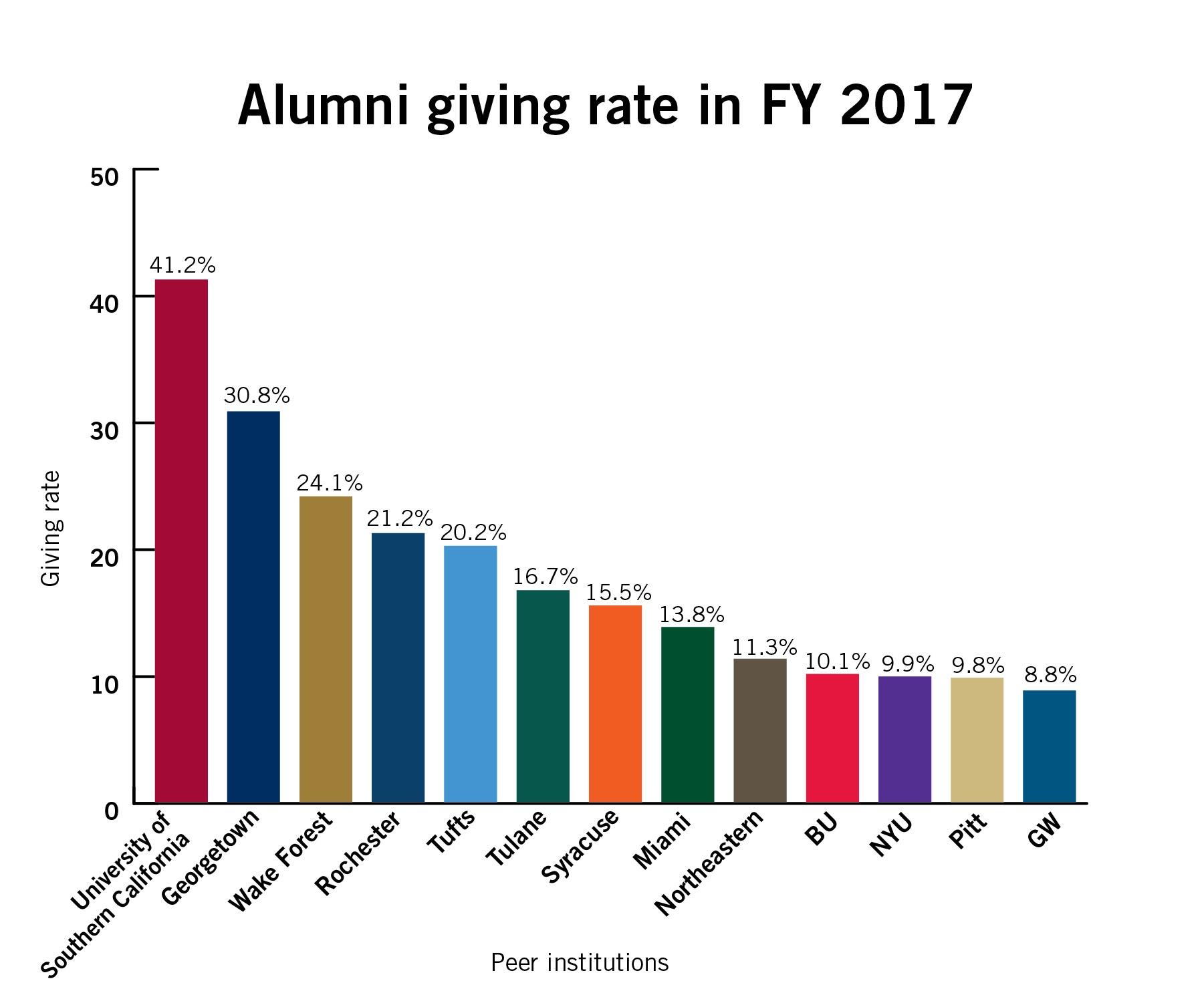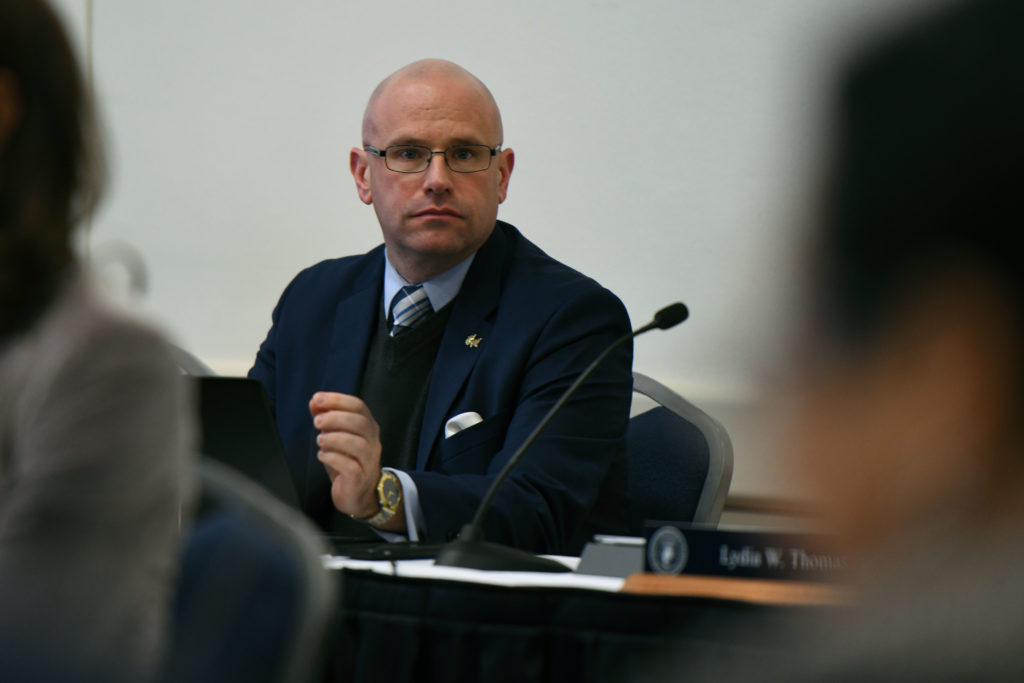Of the University’s 12 peer institutions, GW has the lowest percentage of alumni giving back to their alma mater.
At 8.8 percent, the proportion of alumni who donate to GW is the lowest out of the University’s peer institutions, which includes schools like the University of Southern California and the University of Pittsburgh, according to U.S. News & World Report data. GW’s giving rate has dropped at least three percentage points over the past seven years – hitting a low the year after the conclusion of the University’s largest fundraising campaign.
The average alumni giving rate among the University’s peer group – which includes schools that GW has deemed similar in endowment size and research profile – is about 18 percent, nearly 10 percentage points higher than GW’s rate in fiscal year 2017, according to U.S. News data.
Matt Manfra, the senior associate vice president for alumni relations, said the alumni giving rate has hovered between 8 and 9 percent for the past five years and fell to 8 percent in fiscal year 2018 – a year after the conclusion of the University’s largest-ever fundraising campaign which raised $1 billion and garnered support from more than 40,000 alumni.

Emily Recko | Graphics Editor
Source: U.S. News & World Report
The alumni giving rate reached 11 percent in 2007.
“The Division of Development and Alumni Relations is always exploring new ways to engage our alumni,” he said.
The University of Southern California had the highest alumni giving rate of GW’s peers at 41.2 percent, and the University of Pittsburgh barely surpassed GW with a 9.8 percent giving rate.
D.C. schools averaged giving rates of 16 percent, not including Gallaudet University, which did not report its giving rate in 2017. Georgetown University’s rate was an outlier at 30.8 percent and American and Howard universities tallied 6 and 9.9 percent, respectively.
Manfra said that not all alumni engage with the University through monetary donations, adding that some graduates volunteer their time for the University by mentoring students or supporting regional admissions teams.
He said officials typically review peer institutions’ philanthropy data to “compare performance, share ideas and review best practices around alumni and donor engagement and stewardship.”
He said alumni giving helps to fund scholarships, fellowships, faculty, research and other student resources.
“That’s why philanthropy and constituent engagement is one of the University’s highest priorities,” he said.
Since University President Thomas LeBlanc arrived on campus last year, officials have prioritized alumni giving and philanthropy, hiring a new chief fundraising officer and embarking on alumni tours across the country.
The Board of Trustees also set out to improve alumni giving last fall with the creation of a new task force focused on the subject. Officials announced in February that the group would continue its work this year.
But externally, officials have also put money into fundraising consulting firms – and have typically received a lower return on the efforts than peer schools, according to a Hatchet analysis in February.
Alumni relations experts said the giving rate is continually negatively affected by growing class sizes and increased student debt – making it more difficult for institutions to solicit donations at the same pace as in years past.
Greg McCracken, director of the University Fund at the West Virginia University Foundation at the West Virginia University Foundation, said boosting the alumni giving rate takes years because the freshman class size continues to grow – making it more difficult to keep the same percentage of graduates donating from year to year.
The alumni giving rate across the country dropped by 50 percent in 40 years, according to a 2014 report from the Council for Advancement and Support of Education.
“Now, more than ever, it really takes a lot to build relationships with past alums, to keep them engaged, and make them understand what are the benefits of giving back to the institution,” he said.
Heather McDonald, the assistant vice president of development at the University of Connecticut, said she tries to inform potential donors about how alumni giving rates affect the college’s ranking in U.S. News & World Report. She said alumni often do not know that donating and increasing the alumni giving rate could help increase the school’s ranking – and therefore increase the value of their degree.
“We use that to say thank you and to say that this will have an impact,” she said. “I think that’s helping to retain donors.”
GW ranked in the top 50 best colleges before 2011 but dropped off the next year after officials admitted that they inflated admissions data. Since then, the ranking has hovered in the 50s – but dropped to No. 63 in the 2018 list released Monday, according to U.S. News.
John Lofthus, the associate director of alumni affairs at the University of California Santa Barbara, said alumni giving is falling across the country because of increased student debt – meaning students don’t have the means to donate money to GW as past classes had.
“It’s a lot more challenging for universities,” he said. “People are less likely to give to their alma mater now.”
Lofthus said for a well-recognized, private university, 8 percent is considered low, but that the school’s 27,000-student enrollment could make it difficult to give special attention to all graduates.
“The reality is that if you want alumni to give, you need to build relationships and get them involved,” he said.





